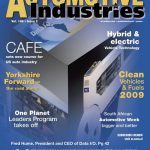All major car manufacturers are currently producing and/or developing vehicles with electric drives – be it totally electric or hybrid of one flavor or another.
Electric empowered vehicles seem to be the holy grail – promising zero tailpipe emissions, decreased reliance on foreign petroleum resources, noise reduction, and high power at low speeds, among other blessings.
Integrating these new technologies into our modern vehicles is enhanced by digital electronics as embodied in modern electronic control units (ECUs).
Automotive Industries recently spoke with Kevin Kott, president of dSPACE Inc. North America. dSPACE specializes in solutions for the development and testing of ECUs for automotive and aerospace applications, including electric drives.
AI: What is going on with Electric motors in vehicles?
Kott: Electric motors have been incorporated in vehicles for quite some time. Electric windshield wipers, electric windows, electric hatch doors and trunks, and air conditioning fans are a few examples. What is relatively new is the proliferation of motors in applications such as full electric or hybrid drives, electric steering, electric brakes, oil pumps, water pumps, and stop-start-generator systems.
Many of these new electric drives are now placed in safety-critical vehicle functions which are highly dependent on electronic communications with other systems or sensors in the car. Because of the higher voltages and power consumption of motors involved in motion of the vehicle, the ability of the battery system to provide adequate power and state of charge is more critical than ever. The controls for all these functions need to be fast, accurate and robust, placing emphasis on design, development, and testing of ECUs and their controlled systems.
AI: Give us a high level description of how electronic controls are developed?
Kott: Because of the newness of electric drives in vehicle applications, controls designers have the benefit of being able to design most of the system using a technique called Model-Based Design. Mathematical models of all systems to be controlled are developed, along with models of the control algorithms. Thus, the entire system can be simulated mathematically on a PC, well before components – such as motors or ECUs – have been manufactured. These models become the reference standard by which subsequent stages of development are compared to, to determine if the system is performing properly.
After the controls models are performing as intended, the next step is to produce software that will reside on an actual production type microprocessor, instead of the one on the PC used in simulations. Modern development tools such as those produced by dSPACE and others, allow the graphically developed algorithms to compile into useable C code automatically. This code can be then loaded into a prototyping system where further development of the ECU software takes place.
Such prototyping systems provide flexible, model-based development environments that allow the developer to find and eliminate design faults on-the-spot. Electric drive function designs can be optimized by connecting the prototyping controller to a test bench, e.g., a dynamometer with the motor, or in an actual vehicle. Due to their compact size and design for rugged conditions, dSPACE prototyping systems can be installed in the vehicle for more realistic conditions.
AI: What is the best method for testing the functionality of ECU designs?
Kott: After the ECU functions have been developed on the prototyping system and then implemented on the production ECU, they have to be tested thoroughly. With hardware-in-the-loop (HIL) simulation, different motor varieties and ECU combinations can be tested. In the HIL, the vehicle dynamics and other vehicle systems that affect the electric drive ECU performance are simulated. If available, some actual systems can also be connected to the HIL to further improve correlation to the real world.
A major feature of HIL testing is its ability to be automated so that numerous operating conditions can be tested without human intervention 24/7. Using automation, when some part of the system has been changed, all previous tests can be re-run to ensure that nothing has been negatively affected by the change. Another important feature of HIL testing is the capability of inserting faults into the system – to simulate all of the possible problems that might face the vehicle in field operation. Circuit shorts, circuit breaks, shorts to power, etc. can all be simulated and run hands off. Testing in this manner is extremely reproducible, since the environmental conditions and operating cycles are controlled in the HIL.
AI: What challenges come into play when testing ECUs for electrical motors?
Kott: ECUs controlling electrical motors, used in hybrid electric vehicles or electric steering systems, are generally integrated in complex, distributed vehicle communication networks. This makes it essential to test interactions with other ECUs and the network’s ability to accurately send and receive signals and commands. Challenges include HILs that must produce higher power level required for electric drives compared to conventional drive applications, higher dynamics of electric drives, special I/O requirements, such as precise capturing of digital gate driver signals, and a very high sampling frequency required for the real-time models. dSPACE offers specially-tailored hardware and software solutions to meet these requirements.
AI: Does dSPACE offer other tools specifically for electric drives development?
Kott: We offer a complete and integrated tool set for electrical drive ECU development. The development cycle that I described earlier can be easily implemented using dSPACE tools. Our Automotive Simulation Models (ASM) for electric components provide generic but easily adaptable real-time models of electrical systems suitable for the initial model-based design. Then, rapid prototyping of the ECU controller can be performed using a dSPACE MicroAutoBox and RapidPro signal conditioning and power stages systems.
Production Code for the production ECU is automatically generated from the graphical modeling software (usually Simulink from TheMathWorks™) using dSPACE’s TargetLink.
Of course we offer HIL systems for all automotive ECU testing applications. Finally, our Calibration Systems are available for the final touches that are made in fine-tuning the vehicle controls to achieve the polished vehicle functions that consumers expect from our OEM customers.
To learn more about dSPACE and its solutions, visit www.dspace.com.














































 The United Kingdom like the rest of Europe and indeed the world is trying to revitalize its industry
The United Kingdom like the rest of Europe and indeed the world is trying to revitalize its industry General Automotive Company Engages Investment Banker Jesup & Lamont
General Automotive Company Engages Investment Banker Jesup & Lamont Parrot will be launching soon new products with top-level German car brands by early 2010
Parrot will be launching soon new products with top-level German car brands by early 2010 DAIO - Supplying solutions
DAIO - Supplying solutions Automotive Industries spoke to Lennart Josefson, director of the Swedish Hybrid Vehicle Centre
Automotive Industries spoke to Lennart Josefson, director of the Swedish Hybrid Vehicle Centre


